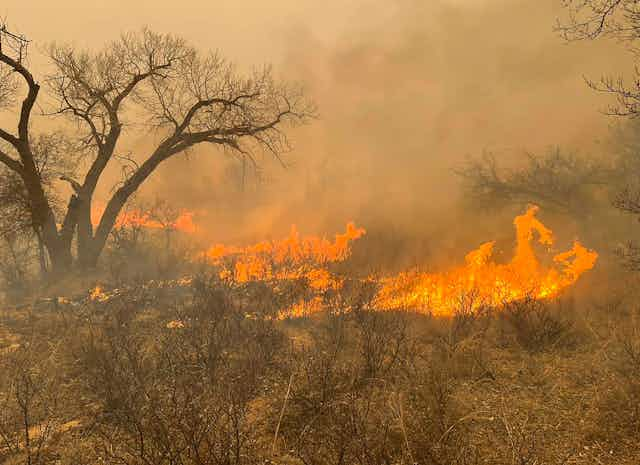Strong winds spread the largest wildfire in Texas history across more than 1 million acres of rangeland in the Panhandle, the heart of the state’s cattle-producing region, and into Oklahoma in late February 2024. Light precipitation on Feb. 29 helped firefighters as they tried to contain the Smokehouse Creek Fire and other blazes threatening homes and livestock, but the heat and winds picked up again on March 2. At least two people died and scores of structures, including homes, burned.
Karen Hickman, a grassland ecologist at Oklahoma State University and president of the Society for Range Management, explained why the fires spread so fast, the risks to livestock and how quickly these ecosystems can recover.
How did the fires spread so far so quickly?
This region of Texas and Oklahoma is mostly rangeland where cattle graze. A combination of higher-than-average temperatures and low humidity had dried out the dormant plants. When the winds picked up following a couple of hot, dry days, all it took was a spark to start a wildfire.
The Texas Panhandle is mostly shortgrass prairie species that evolved with fire. But Texas also has Conservation Reserve Program fields planted with perennial species that might be mid- or tall grasses. Those taller grasses have a higher fuel load that can feed a fire more than the short grass species.
Across the border, that area of Oklahoma is more rugged and has another problem: a lot of eastern red cedar that are native but have expanded as invasive species because of the lack of periodic fire. When mature cedar trees burn, they can send embers flying, increasing the risk to homes and towns.
When fires spread that fast, it often means embers are blowing ahead of the actual fire and across any potential firebreaks that exist.
The wind’s shifting direction – it sometimes changed direction two or three times in a day – also made the fire harder to control. Fire crews and ranchers can try to protect the area ahead of the fire, only to see the wind shift and blow the fire in another direction. It’s dangerous to people and livestock, and it makes it hard to stop the fire’s spread.
What is in the path of these fires?
Those lands are either being rested through the dormant season or being grazed by livestock this time of year, and there are new calves, as well. Texas livestock producers have been trying to move their cattle to safety, but in some cases they had to cut the fences and let the cattle go on their own.
In Oklahoma’s rougher terrain and canyons, it can be even harder to get the cattle out because they go into the canyons to get away from the fierce winds.
For livestock producers, the immediate needs will be saving and then gathering their herds again.
Some herds will die in the fire, and cattle will be injured. Fires like these also burn fences and damage the windmills that power wells, and they can melt plastic water tanks. So, many producers will have to find new sources of both food and water for their animals. Homes are also at risk and several have burned.

The rangelands are dominated by people who are supportive of their neighbors, so typically, the surrounding counties will offer donations. There are some concerns about hay from areas farther away and the risk of invasive species. The Panhandle saw that with red imported fire ants that arrived in hay bales after fires in 2018. But the immediate concern for ranchers is to provide food and water for their livestock.
How quickly can the rangeland recover?
The grasses will be able to sprout back and recover fairly quickly. Over winter, they are alive below ground. Only the dead part of the plants above ground burned.
In those systems with perennial plants, once it rains and temperatures rise, the grasses and forbs will sprout back within a few weeks. The plants will recover nicely as long as we’re not in a long-term drought.
The grassland may even see a benefit if the fire removes invasive species like eastern red cedar in Oklahoma. In some areas, people have been hesitant to conduct prescribed fires, and that has led to an overgrowth of woody plants, such as sumac and sand plum. If the fire clears out some of that overgrowth and the eastern red cedar, the prairie grass and forb species will regenerate in those areas, restoring wildlife habitat.
Where the vegetation burns away, the black surface will increase the soil temperature, activating perennial grasses and promoting resprouting. This speeds up their growth.
These are really resilient ecosystems. But the immediate concern in the coming weeks is for cattle producers to find ways to feed and water their livestock while the rangeland’s native plants regrow.
This article, originally published March 1, 2024, has been updated with damage to homes and wind gusts picking up again.

